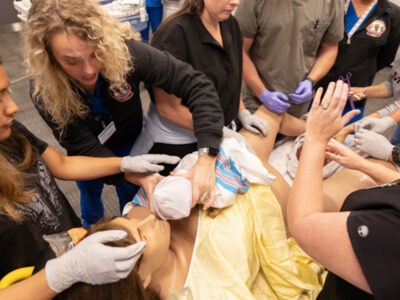This post is also available in: Español (Spanish)
Research and long histories of practice show that community-based birth workers, including doulas and midwives, have played an important role in helping to successfully deliver countless babies in safe, supportive environments. Yet the United States’ healthcare system has historically not recognized or reimbursed the services provided by doulas and midwives in a standard way. States have begun passing and implementing policies that address training, certification and reimbursement of these birth workers, however, policies, definitions and standards vary widely. Ultimately, the midwifery model of care is a holistic approach to pregnancy, childbirth and postpartum support that emphasizes personalized, patient-centered care and gives birthing individuals the ability to have a birthing experience that is effective while also reducing costs and improving health outcomes.
The spectrum of birth workers includes:
- Doulas: Non-clinical support providers offering physical, emotional and informational support during pregnancy, birth and postpartum periods.
- Community Doulas: Culturally congruent birth workers providing education and support.
- Midwifery Professionals: Trained birth workers who provide care during the prenatal, birth and postpartum periods. Midwives may be trained to practice in birthing centers or home births without the presence of physicians or in hospitals alongside physicians. They include a variety of professionals, including certified nurse midwives, certified midwives, certified professional midwives and traditional midwives, as practices vary by state.
Midwifery Models of Care Improve Health Outcomes and Reduce Costs
Research demonstrates significant advantages of midwifery-led care:
- Increased likelihood of vaginal birth
- Decreased cesarean delivery rates
- Reduced preterm birth occurrences
- Potential for $4 billion in health care cost savings by increasing midwife-led care to 20% (up from around 8% currently)
Policies and Approaches Expanding Midwifery Care Can Make a Difference
Integrating midwifery models of care can improve maternal and infant health outcomes, reduce healthcare costs and provide culturally congruent support centered around the person giving birth and their baby. The following actions would strengthen the field and make midwifery more affordable and available:
- Workforce Pipeline: Invest in the training of new midwives by compensating experienced practitioner instructors and midwife students.
- Independent Practice: States could adopt licensing processes based on education and certification, rather than requiring midwives to have contracts with physicians. This would allow midwives to practice more freely and expand their reach.
- Parity in Reimbursement: Midwifery would expand as a practice if midwives received the same reimbursement rates as physicians for providing identical services, including changing state regulations so that midwives receive 100% of physician fees from Medicaid.
- Independent Admitting Privileges: Granting midwives the ability to independently admit and discharge patients in hospitals would significantly expand their scope of practice and ability to provide continuous care.
- Increased Integration: States with higher midwifery integration consistently show better maternal and infant health outcomes. If policymakers work to increase the percentage of midwife-attended births across all states, the result will be better birth outcomes for children and families.
- Expanding Services in Areas of High Need: With data demonstrating ongoing challenges in outcomes for people giving birth and babies, particularly for those facing significant racial disparities, policies specifically targeting the expansion of midwifery services in underserved communities would help reduce persistent disparities and better ensure healthy experiences and results in birth and the first year of life.
An International Alliance for Midwifery Care
The role of Indigenous midwives is not only culturally vital and medically effective—it is also protected under international human rights frameworks. The United Nations Declaration on the Rights of Indigenous Peoples (UNDRIP) affirms the right of Indigenous communities to maintain and strengthen their distinct institutions, including traditional health practices and knowledge systems (Articles 24 and 31).
The Continental Alliance of Indigenous Midwives of the Americas, of which Nich Ixim is a founding member, calls for the free and full exercise of midwifery without discrimination, criminalization, or exclusion. Their demands include:
- Legal recognition of traditional midwifery as an Indigenous right;
- Protection and transmission of ancestral knowledge;
- Access to respectful, culturally safe healthcare for Indigenous women and families;
- Participation in decision-making on health policies that affect their communities.
These demands were reaffirmed during the United Nations Permanent Forum on Indigenous Issues (2024), and reflected in Recommendation 27 of its final report.
Read the 2024 UNPFII resolution: https://social.desa.un.org/issues/indigenous-peoples/unpfii/23rd-session
Click on “Report of the Twenty-third Session,” and then click on the hyperlink to get to the report. It is recommendation #27.

Explore videos and stories demonstrating the beauty and unity that accompany birth. Experience this sacred rite of passage through the eyes of birth workers and the families they serve in Alaska, Mexico and New Mexico.
All photos courtesy of BBC StoryWorks Commercial Productions







Comments